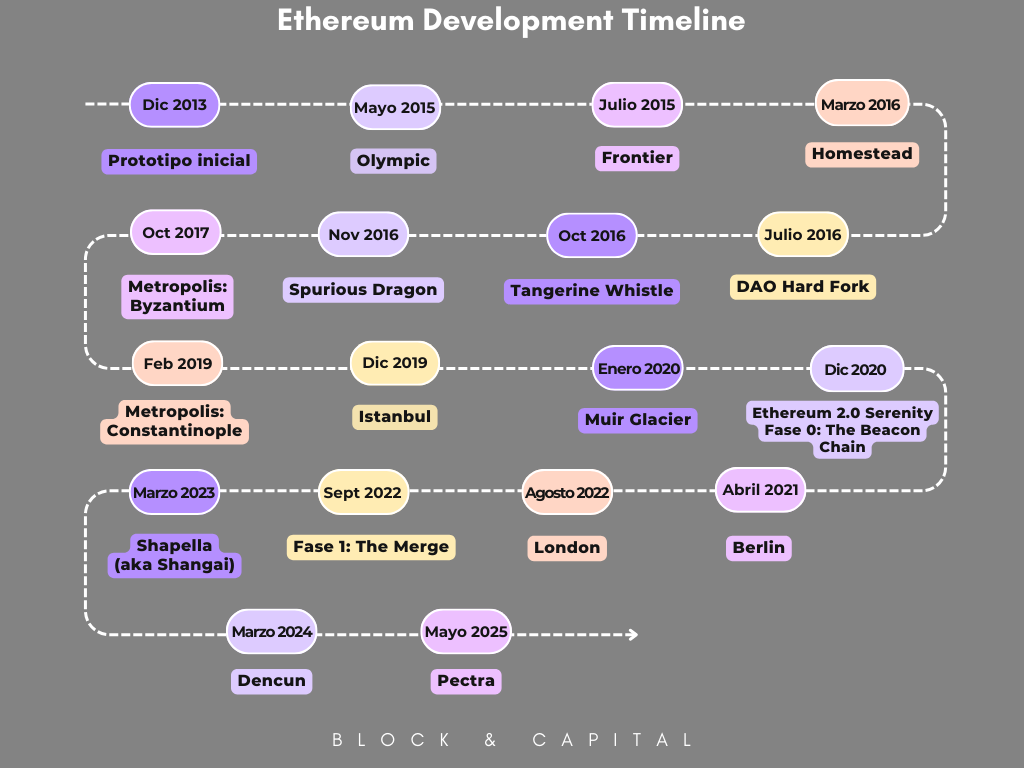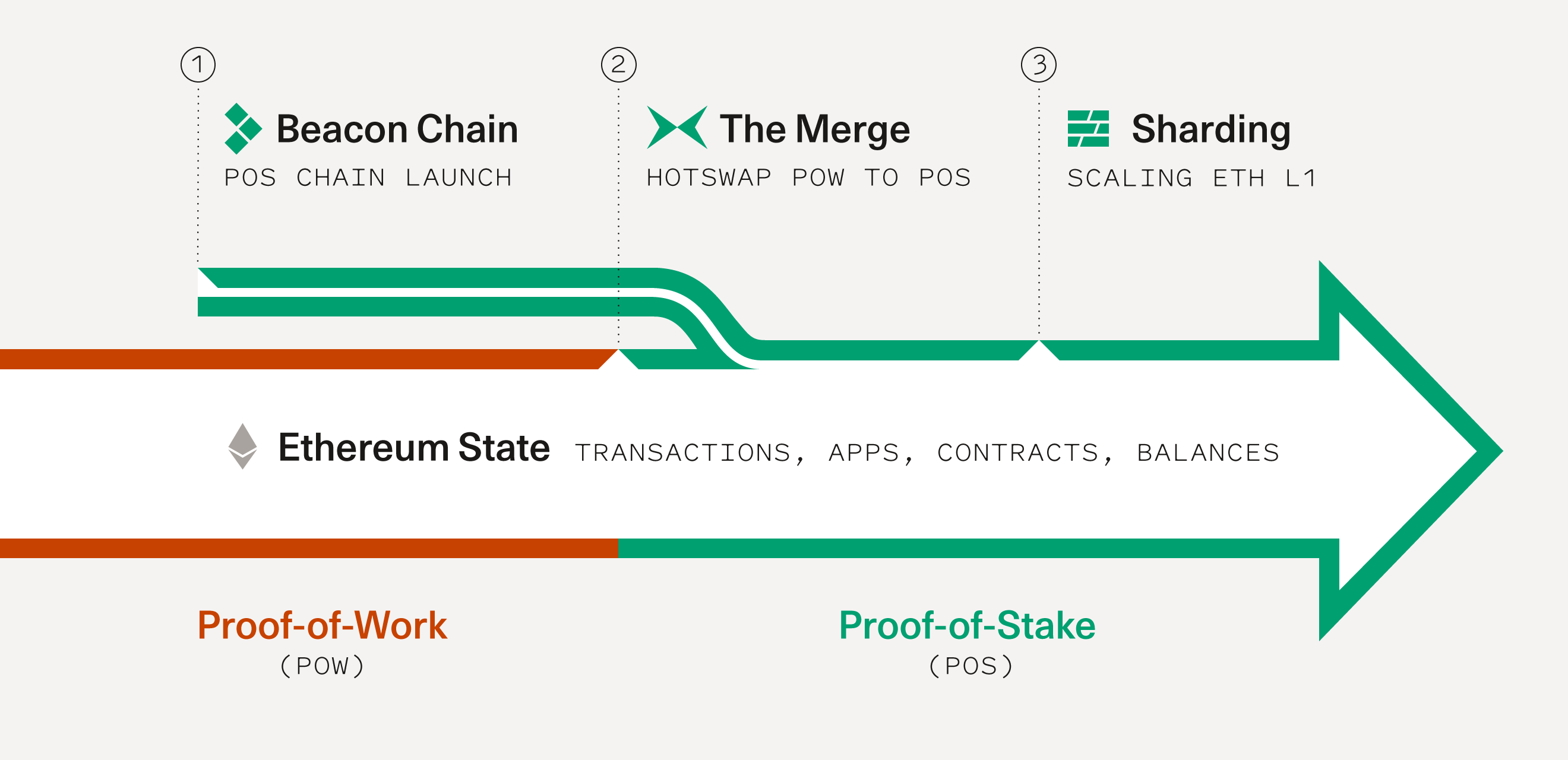The introduction to the world of Ethereum takes us into an unprecedented technological innovation that has transformed the way we conceive of digital transactions, digital property and the automation of processes through smart contracts. To fully understand the impact and scope of Ethereum, it is essential to explore its origin, the basic principles of the blockchain technology on which it is based, its vision and goals, as well as the workings of its native cryptocurrency, ether.
Origin of Ethereum
In 2013, Vitalik Buterin, a programmer and researcher in the field of cryptocurrencies, presented the initial idea for Ethereum. Inspired by Bitcoin’s limitations in terms of functionality and usability, he set out to devise a platform that would not only act as a digital currency, but also enable the development of decentralized applications (dApps). After a successful crowdfunding in 2014, Ethereum was officially launched in 2015, ushering in a new era in blockchain technology.
Blockchain Basics
Blockchain technology is at the heart of Ethereum. At a fundamental level, a blockchain is a secure, distributed transaction ledger that is immutable and transparent. Each block on the blockchain contains a set of transactions, and once it is added to the chain, the information it contains becomes immutable and public. This ensures data integrity and reduces the possibility of fraud or manipulation.
Ethereum’s vision and goals
Ethereum’s vision is to create a decentralized platform that allows developers to build and deploy applications without relying on a central authority. This includes not only the transfer of value through its native cryptocurrency, ether, but also the execution of smart contracts that can automate, guarantee and verify agreements without the intervention of intermediaries. On the other hand, the Ethereum Foundation, a non-profit organization, plays a crucial role in this ecosystem, providing support for research, development and promotion of the platform, ensuring that it stays true to its principles of openness, decentralization and accessibility.
Description and functionality of ether
As we discussed earlier, ether (ETH) is Ethereum’s native cryptocurrency, used to compensate validators for performing transactions and executing smart contracts on the network. In essence, ether acts as the “fuel” that allows the network to function. Its smallest unit, similar to the cent for the euro, is the “wei,” where 1 ether equals 1×1018 wei. This high divisibility facilitates transactions of small values, being crucial for the efficient operation of decentralized dApps and smart contracts on the blockchain. More than just a digital currency, ether plays a key role in the security and efficiency of the platform, incentivizing participants to act with integrity and contribute to transaction processing.
Ethereum development and key features
Ethereum has stood out as an innovative platform that goes beyond basic cryptocurrency transactions, thanks to its innovative approach that has facilitated the development of decentralized applications (dApps), smart contracts and much more. This capability is based on key features such as its flexibility and a robust and secure infrastructure, which has enabled the creation of decentralized autonomous organizations (DAOs) and decentralized finance systems (DeFi).
An essential component of this platform is the Ethereum Virtual Machine (EVM), which, being Turing complete, can run any program or algorithm. This set of features not only highlights Ethereum’s role as a leader in Blockchain innovation but also opens up endless possibilities for its application in various sectors.
Smart contracts and dApps
Smart contracts are self-executing programs that are activated when certain predefined conditions are met. These contracts enable the automation of agreements and processes without intermediaries, which significantly reduces fraud risks and operating costs.
dApps, on the other hand, are decentralized applications that operate on the Ethereum blockchain, leveraging smart contracts to operate transparently and securely, without relying on a central authority to control the application.
Decentralized Autonomous Organizations (DAOs)
DAOs, or Decentralized Autonomous Organizations, are digitally managed entities without a centralized hierarchical system. These organizations are based on smart contracts and allow for democratic management by their members, who make collective decisions about the development and direction of the organization. Ethereum has simplified the creation and operation of DAOs, demonstrating their potential to transform the way organizations can be structured and function.
Decentralized Finance (DeFi) and Non Fungible Tokens (NFTs)
The term “DeFi” represents a set of financial applications and projects that operate on the blockchain, offering financial services without the need for traditional intermediaries such as banks. This includes loans, insurance and trading platforms, among other services that we will explore at the end of the article. NFTs, on the other hand, are unique tokens that represent ownership over digital or physical assets, enabling the trading of artwork, collectibles, and more, in a secure and verifiable way on the blockchain.
Ethereum Virtual Machine (EVM)
The EVM is the execution environment for smart contracts on the Ethereum network. It is described as Turing complete, meaning that it can run any algorithm, providing the necessary time and resources. This feature makes Ethereum exceptionally flexible and robust, as it can run virtually any logic program that developers wish to implement on the network.
Ethereum 1.0: Challenges and Solutions
Despite its innovations, Ethereum 1.0 faced several major challenges, including scalability, security, power consumption and governance issues. Scalability refers to the network’s ability to efficiently handle a large number of transactions efficiently, without experiencing bottlenecks. The original consensus model, Proof of Work (PoW), involved high energy consumption.
To address these challenges, Ethereum has been working on the transition to Ethereum 2.0, which includes the implementation of the Proof of Stake (PoS) consensus model to reduce energy consumption and the introduction of techniques such as sharding to improve network scalability and security. These enhancements address the limitations of the previous model and strengthen Ethereum’s infrastructure for the future.
Transition to Ethereum 2.0 (Serenity)
The transition to Ethereum 2.0, also known as Serenity, represented a considerable evolutionary leap for the platform. The primary goal of this upgrade is to address some of the most critical challenges faced by Ethereum 1.0, while maintaining the vision of decentralization and accessibility. Through a series of technical updates, Ethereum 2.0 aims to significantly improve network performance and capacity.
Blockchain and Proof of Stake (PoS)
The transition from the Proof of Work (PoW) to Proof of Stake (PoS) consensus model through the implementation of the Gasper protocol is one of the most important features of Ethereum 2.0. PoS changes the way blocks are validated and created: instead of relying on miners solving mathematical problems using a large amount of energy, validators are selected to propose and validate the next block based on the amount of ETH they have “locked” as a stake. This change not only significantly reduces energy consumption, but also increases security and reduces the possibility of centralized attacks.
Ethereum Virtual Machine (EVM) vs Ethereum Web Assembly (eWASM)
The introduction of Ethereum Web Assembly (eWASM) in marks a significant step forward, as it is set to replace the current Ethereum Virtual Machine (EVM). eWASM will improve code execution, efficiency and flexibility in smart contract development, representing a leap towards a more enriching development experience. This upgrade will allow developers to employ a wider diversity of programming languages and tools, which will enhance innovation and the creation of more complex and efficient applications.
Improvements in scalability, security and energy efficiency
Ethereum 2.0 represents an evolutionary leap towards a more advanced blockchain infrastructure, effectively addressing three crucial pillars: scalability, security and energy efficiency. Through a meticulous integration of innovations at the L1 and L2 layers, Ethereum is setting new standards in the blockchain world.
Layer 1 (L1)
The Layer 1 (L1) implementation of shard chains further amplifies the ability to process transactions and store data. By dividing the network load into multiple parallel chains, shard chains reduce the load on the core network, allowing for faster and more efficient transaction processing. This approach not only improves scalability by allowing more transactions to be processed simultaneously, but also strengthens security by distributing transactions across multiple chains, making it harder to attack the network.
With the transition to PoS, Ethereum has reduced its power consumption by 99.95% compared to the previous PoW system. This drastic reduction not only addresses growing concerns about the environmental impact of cryptocurrencies, but also makes block validation and network participation more accessible and less costly from an energy perspective.
Layer 2 (L2)
At Layer 2 (L2) Optimistic Rollups and ZK-Rollups facilitate off-chain transaction processing, improving the number of transactions per second the network can process. This reduces gas costs and maintains a high level of security, highlighting Ethereum’s commitment to innovation and energy efficiency.
In March 2024, the “Cancun-Deneb” upgrade marked a major milestone with the introduction of Proto-Danksharding, also known as EIP-4844. Through the incorporation of “data blobs” into the blocks, Proto-Danksharding enables rollups to transmit their data more efficiently and economically. This advancement is instrumental in reducing transaction costs at higher layers, thus facilitating cheaper access for users and promoting wider adoption of Ethereum-based applications.
This development is an intermediate step towards implementing full Danksharding, with a focus on optimizing scalability. This strategy focuses on significantly expanding the space available for rollups to store compressed transaction data. Doing so would facilitate support for hundreds of rollups, allowing Ethereum to process a massive volume of transactions per second. This expansion of data space not only promises to improve network efficiency and capacity, but also lays the foundation for an Ethereum blockchain capable of supporting large-scale transactions.
Ethereum 2.0 architecture and underlying technology
The transition to Ethereum 2.0 introduced significant changes to the platform’s underlying architecture and technology. These improvements aim to address the challenges present in Ethereum 1.0, resulting in a more robust and sustainable infrastructure for decentralized applications and smart contracts.
Block structure and transaction flow
Block structure
Blocks maintain an organized structure that includes:
- Block header: which contains essential block metadata, such as the previous block’s identifier, timestamp, and Merkle tree root.
- Transaction tree root: A representation of all transactions included in the block, organized in a Merkle tree, which facilitates quick transaction verification.
- State tree root (Patricia Trie): Represents the complete state of the system at the time of the block, also organized in a Merkle tree, allowing for verification of any state of the network at any point in time.
- Transaction list: All confirmed transactions in the block.
- Proof of Stake (PoS): In Ethereum 2.0, block validation is done through PoS, requiring validators to “stake” ETH as a guarantee of their honesty to process and validate transactions.
Transaction flow
Transactions follow a detailed process from creation to confirmation:
- Transaction creation: The user generates a transaction, specifying the recipient, amount and optional data.
- Gas allocation: Each transaction requires a specific amount of “gas”, which is calculated based on the complexity of the transaction.
- Fee estimation: The total fee is estimated in wei, based on the gas required and the gas price at that time.
- Signing and submitting the transaction: Users signs the transaction with their private key and sends it to the network.
- Validation and execution: Validators verify the transaction and, if valid, execute it.
- Gas consumption and fee payment: The gas consumed is converted into fees that are paid to the validator.
- Confirmation and propagation: Once confirmed, the transaction is included in a block and propagated throughout the network.
Layered architecture
When we talk about layered architecture, we refer to the organizational structure of the protocol and its ecosystem, where different layers have specific responsibilities. Below, we will explore how each of these layers contributes to this ecosystem, highlighting the innovations and technologies that define the architecture of this advanced blockchain platform.
Consensus protocol layer (PoS)
Gasper combines the Casper the Friendly Finality Gadget (Casper-FFG) and the LMD-GHOST fork election algorithm to form Ethereum’s POS consensus mechanism. Casper-FFG is responsible for finalizing blocks to ensure that new network participants reliably synchronize with the main chain. On the other hand, LMD-GHOST helps nodes select the correct fork by evaluating the accumulated votes.
Finality in this context refers to the fact that a block, once finalized after a two-step update process involving a two-thirds majority vote, cannot be reversed except under extreme conditions such as a major consensus failure. Validators are rewarded for appropriate behaviors and face sanctions, such as loss of participation, for dishonest acts. In summary, Gasper implements a robust PoS consensus system that promotes honesty and security in the Ethereum 2.0 network.
Network layer
It uses advanced protocols to ensure efficient and secure communication between nodes. It incorporates technologies such as libp2p, a modular and extensible network protocol framework that facilitates the creation of decentralized peer-to-peer applications. This layer is responsible for the propagation of transactions and blocks, ensuring that all information is distributed quickly and reliably across the network.
Application layer
The application layer is where dApps and smart contracts are developed and operated. The EVM is the central execution environment for smart contracts in Ethereum, allowing them to be executed in isolation and securely. However, as we mentioned earlier, Ethereum 2.0 plans to introduce eWASM, an enhancement over the EVM that promises to offer greater flexibility, efficiency and the ability to use multiple programming languages in the development of smart contracts. This opens the door to a new generation of more powerful and efficient decentralized applications.
User interface layer
At the user interface layer, tools and platforms such as Metamask provide an intuitive and accessible means for users to interact with Ethereum dApps and services. This layer is critical to ensuring that blockchain technology is accessible to all audiences, simplifying interaction with complex decentralized transactions and improving the overall user experience.
Decentralized storage layer
In Ethereum’s decentralized storage layer, technologies such as InterPlanetary File System (IPFS) and Swarm are employed to provide distributed data storage solutions. These technologies ensure information accessibility and security by enabling dApps to store data in an efficient and censorship-resistant manner.
Together, these layers and underlying technologies form the foundation of Ethereum 2.0, promising a more scalable, secure and sustainable network that can serve as the backbone for the Web3 Internet generation.
Ethereum governance and updates
Governance is a dynamic and complex process involving various stakeholders, including developers, validators, users and other community participants. This system allows Ethereum to adapt and evolve in response to the needs and challenges of its ecosystem.
Network Improvement Proposal and Adoption Process (EIPs)
Ethereum Improvement Proposals (EIPs) are the primary mechanism through which new features and enhancements to the Ethereum network are proposed, discussed and adopted. An EIP describes technical standards, including protocol changes, smart contract features and governance rules. The process is as follows:
- Proposal: Any member of the community can propose an EIP.
- Discussion and review: The proposal is discussed and reviewed by the community. This may include discussions in forums, developer meetings, and other communication channels.
- Acceptance: For an EIP to be accepted, it must gain the support of a significant majority of the community, including Ethereum’s core developers.
- Implementation: Once accepted, the EIP is implemented in the Ethereum source code, and scheduled for a future network update, as part of a hard fork or soft fork.
Ethereum governance model
The governance model is based on decentralization and community collaboration, where the voice of the community is fundamental. While the core developers have an important role in technical direction, implementing changes requires the consensus of the community as a whole, including validators in Ethereum 2.0. This structure ensures that no single actor has absolute dominance over the network, aligning the interests of all participants.
History of important updates
Ethereum has undergone several major upgrades throughout its history, many of which have been implemented through hard forks:
- Homestead: The first major update that provided several security and stability improvements.
- DAO Fork: A controversial hard fork implemented in response to “The DAO” exploit. This update returned funds to affected investors, but also generated a community split and gave rise to Ethereum Classic (ETC).
- Byzantium and Constantinople: These updates were key parts of the Metropolis update, which was rolled out over two phases and brought considerable improvements to the efficiency, security and functionality of smart contracts.
- Istanbul: This update introduced compatibility changes, as well as improvements to the privacy and scalability of the network.
- The Merge: Refers to the merging of the blockchain with the Ethereum 2.0 Beacon Chain, marking the transition from Proof of Work (PoW) to Proof of Stake (PoS).
- Cancun- Deneb: The Cancun-Deneb (also known as Dencun) update is a key milestone for Ethereum, not only promising to increase platform efficiency and make L2 transactions cheaper, but also laying the groundwork for the long-awaited transition to full Danksharding.
- Pectra: It is the most significant upgrade since The Merge and combines the Prague (execution layer) and Electra (consensus layer) proposals, introducing 11 EIPs. Key changes include account abstraction (EIP-3074), which will enable smoother user experiences; improvements to temporary smart accounts (EIP-7702); an increase in the staking limit per validator to 2,048 ETH (EIP-7251); and greater efficiency in transactions and validator exits. Additionally, it doubles the blob capacity per block, optimizing the scalability of L2 solutions and laying the groundwork for a more accessible, efficient, and scalable Ethereum.

DAO Exploit
“The DAO” exploit is a landmark case in Ethereum governance. In 2016, an attacker exploited a vulnerability in the code of “The DAO”, a decentralized autonomous organization, stealing a large amount of ETH. This triggered an intense debate on the principle of “code is law”, dividing the community between those who supported an intervention to reverse the hack (and return the funds to their owners) and those who argued that the immutability of the blockchain should prevail over human error or code vulnerabilities. The final decision to run a hard fork to reverse the exploit generated a split in the community, leading to the creation of Ethereum Classic (ETC), which maintained the original chain without the intervention of “The DAO” hack.
Ethereum adoption and impact
Ethereum’s adoption has generated significant impact in a wide variety of sectors, thanks to its ability to enable decentralized applications and smart contracts. Below are some notable examples of use cases in different sectors.
Use cases in different industries
Decentralized Finance (DeFi)
- MakerDAO: Allows users to block ether as collateral to generate DAI, a decentralized stablecoin tied to the US dollar.
- Uniswap: Decentralized exchange protocol that facilitates the exchange of ERC-20 tokens without a traditional order book.
- Aave: DeFi lending platform that allows users to lend and borrow a variety of cryptocurrencies.
- Compound: DeFi lending platform that allows users to earn interest on their cryptocurrencies or borrow in a decentralized environment.
Non Fungible Tokens (NFTs)
- CryptoKitties: blockchain-based game that allows you to buy, collect and breed unique digital cats in the form of NFTs. It was so popular that it caused congestion on the Ethereum network.
- Decentraland: A decentralized virtual world where users can buy, sell, and develop digital parcels in the form of NFTs.
- OpenSea: The leading marketplace platform for buying and selling unique NFTs, from digital art and virtual collectibles to domain names and more.
- NBA Top Shot: Digital collectibles platform that allows you to buy, sell and collect NBA highlights in the form of NFTs.
Digital identity
- uPort: A decentralized digital identity and credential platform that allows users to register and control their identity without relying on central authorities.
Supply chain and logistics
- IBM Food Trust: Uses blockchain technology to improve transparency in food supply chains, allowing the origin and status of food to be tracked.
Games and entertainment
- Axie Infinity: Ethereum-based battle and trade game where players breed, fight and trade digital creatures called Axies.
- The Sandbox: Virtual metaverse where players can create, own and monetize their gaming experiences.
These examples show how Ethereum has revolutionized multiple sectors and generated a significant impact on the global economy and society at large.
Enterprise Ethereum Alliance (EEA)
The Enterprise Ethereum Alliance (EEA) is a global coalition composed of companies and institutions collaborating to accelerate the adoption of Ethereum technology in the enterprise environment. The EEA plays a key role in solving the challenges organizations face when adopting blockchain by focusing on the following aspects:
- Standards development: The EEA promotes the development of open standards and specifications to ensure interoperability and compatibility of Ethereum-based solutions. This facilitates the integration of blockchain technology into existing enterprise systems and promotes widespread adoption.
- Cross-industry collaboration: By bringing together companies from different industries, the FSS fosters collaboration and knowledge sharing. This enables joint innovation and the development of new blockchain applications that address industry-specific needs.
- Research and Development: The EEA drives research and development of advanced technologies to improve the functionality, efficiency and security of Ethereum in enterprise environments. This includes the development of scalable, secure and efficient solutions that meet the demands of enterprises in terms of performance and security.
With a diverse membership ranging from technology startups to large industrial corporations, the EEA demonstrates Ethereum’s broad potential to transform various aspects of the global economy and society at large. Their work together contributes to establishing a solid framework for the widespread adoption of blockchain technology in the business world.
Resources
Ethereum, as the leading blockchain platform for smart contracts and decentralized applications (dApps), offers a wide range of resources and tools for developers, investors and general users. These resources are essential to understanding, using and contributing to the Ethereum ecosystem. Some of the most relevant resources available are listed below:
- Ethereum.org: The official Ethereum website is a comprehensive source of information, from blockchain basics to advanced technical details, developer guides and educational resources.
- GitHub for Ethereum: Here you will find all Ethereum-related code repositories, development tools and specifications for contributing source code.
- Ethereum Stack Exchange: A Q&A forum dedicated to Ethereum, where developers can share knowledge, solve technical questions and learn about the development of smart contracts and dApps.
- Etherscan: An Ethereum block explorer that provides a detailed interface for viewing transactions, blocks, wallet balances and smart contracts.
- Chainstack: Offers solutions to deploy nodes on the Ethereum blockchain quickly and manage blockchain infrastructures efficiently.
- Infura: Provides an API to connect to the Ethereum network, allowing developers to build and scale their dApps without the need to operate their own node on the Ethereum blockchain.
- MetaMask: A bridge that allows users to interact with the decentralized web (Web3) through a browser or mobile device.
- Truffle Suite: A suite of development tools that facilitates the creation, testing and deployment of smart contracts on the Ethereum network.
- Remix: A browser-based integrated development environment (IDE) for writing, compiling and deploying smart contracts written in Solidity.
- Ethereum Improvement Proposals (EIPs): A vital resource where improvements to the Ethereum platform, fundamental to the governance and development process, are discussed and proposed.
- Ethereum forums and communication channels: Platforms such as Ethereum Magicians, Reddit, and various Discord and Telegram channels serve as spaces for discussion, technical support, and community collaboration.
These resources offer a wide range of tools, information, and community for those interested in exploring, building, or investing in the Ethereum ecosystem.
Conclusion
In this comprehensive article, we have explored the foundations, evolution and future of Ethereum, highlighting its role as a revolutionary platform in cryptocurrencies and blockchain technology. From its humble beginnings to its current position as a leader in the blockchain space, Ethereum has proven to be much more than just a digital currency. Its introduction of smart contracts has opened up new possibilities for automating deals and transactions, while its ability to support decentralized applications (dApps) has catalyzed the creation of a diverse and dynamic ecosystem.
Ethereum has proven its versatility and utility in a wide range of sectors, from finance to art to digital identity. Decentralized autonomous organizations (DAOs) have emerged as an innovative form of governance, while NFTs have revolutionized the way we value and trade art and other digital assets. Moreover, their potential to improve transparency and efficiency in the supply chain and other fields is undeniable.
As Ethereum continues to evolve, its impact and relevance are only destined to grow. With its ability to empower individuals and organizations through decentralization and autonomy, Ethereum is laying the foundation for a more inclusive, transparent and efficient future in the digital economy.
Bonus Track: Reflections on Ethereum
Ethereum’s history is a narrative of ambition, challenges and evolution in the blockchain world. While it attracted pioneering developers, it also saw the departure of some to new platforms such as Polkadot and Cardano, in search of more robust startup solutions than those offered by Ethereum, reflecting the dynamic and competitive nature of the blockchain ecosystem.
A critical moment in Ethereum’s history was the hardfork resulting from “The DAO” incident, revealing a split in the community between those who defend the immutability of the blockchain and those who see value in adaptability in the face of extraordinary events. The decision to execute a hardfork, reversing a transaction due to an exploit in the contract code, not only led to the creation of Ethereum Classic but also incited a deep debate about governance and ethical values within the blockchain ecosystem.
In an interesting contrast, the NXT community faced its own challenge in 2015 with the hack of the Bter exchange, opting for a negotiated solution with the attacker rather than considering a rollback of the blockchain. This approach highlights another possible path within the spectrum of responses to security challenges, emphasizing conflict resolution through dialogue rather than deep technical alterations.
However, despite its ethical dilemmas and scalability challenges, Ethereum has achieved massive recognition and has established itself as the standard for the development of smart contracts and dApps. It demonstrates that in blockchain technology, the ability to cultivate an active and engaged community can be as crucial as the platform’s own technical capabilities.
If you found this article interesting and would like to see the creator of Ethereum introducing the platform, we suggest you watch this lecture by Vitalik Buterin.
Resources:
[1] Whitepaper
[2] Ethereum.org
[3] Sequoiacap: “Understanding the merge”
[4] Consensys: Ethereum, evolved: Pectra
Want to learn more about blockchain technology? Don’t miss these resources!
- Exploring the blockchain technology
- The ultimate guide to the Bitcoin blockchain: Understanding its workings and potential
- Harnessing the power of blockchain technology in businesses
At Block&Capital, experts in IT recruitment in Spain, the UK, the USA, and Andorra, we connect companies with exceptional tech talent. Our mission is to create opportunities where growth and success are within everyone’s reach. Contact us today to find the right IT talent for your company.
Last posts







